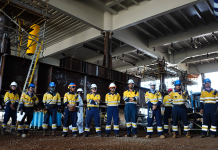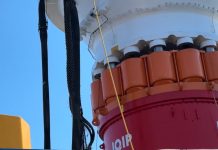Two-bladed offshore wind pioneer Seawind has signed an agreement with windfarm and solar park operator WRE Hellas to develop small scale offshore wind farms in the Greek Aegean Sea to provide the Greek islands with clean and economic energy. Seawind and WRE Hellas will develop a series of mini offshore wind farms in the deep Aegean Sea under the Clean Energy for EU Islands program, a long-term framework to help the 2,000-plus inhabited EU islands generate their own sustainable, low-cost energy. The program was formally launched in September 2017 in Crete by European Commissioner for Climate Action & Energy Miguel Arias Cañete.
Seawind is able to deliver one or two of its two-bladed turbines on floating foundations due to its ground-breaking concept of delivering completely assembled offshore wind-energy units that are launched at site by a semi-submersible vessel. No lifting operation is necessary during the installation phase or for operations and maintenance. The complete units — the wind turbine and support structure — are designed to be installed by sinking, and all O&M operations are carried out onboard with access via air or via sea. Uncoupling the rotor from the shaft by a teetering hinge means there is no requirement for the blade-pitch mechanism with the added benefit of significantly reduced fatigue and ultimate loads. This means a much lighter turbine head and tower, which is beneficial for floating wind turbines.
“The development of economic, clean energy sources is of vital importance for many small Greek islands that rely heavily on tourism,” said Victoria Alexandratou, managing director of WRE Hellas. “Seawind’s technology will enable us to meet this objective at a cost comparable to the wholesale price on the mainland and independent from government subsidies. With this solution, we are getting closer to realizing Martin’s vision of 100 percent clean and economic energy for everybody, which we shared in the ’90s in his German company and out of which came so many important path-breaking companies such as WRE Hellas and Good Energy in the U.K.”
%%0118-Seawind%%
It is critical to preserve the environment and landscape of the Greek islands while developing independence from fossil fuels and decreasing energy costs. Together with Seawind, WRE Hellas will also evaluate various types of energy storage systems to guarantee energy supply 24/7. An important role in this system will be carrying the clean energy via hydrogen for transport use.
Long-term president of the European Wind Energy Association Arthouros Zervos from the National Technical University of Athens said it is a great pleasure to see the tremendous work from the development of the Gamma 60 technology in the ’90s finally coming to such a significant outcome. He said he believes Seawind can give new impetus to investments in Greece.
“Seawind’s approach to assemble the entire system onshore and launch at sea by semi-submersible vessels is the key to bringing down the cost of offshore wind and being able to install one or 100 turbines in a very economical way,” said Martin Jakubowski, CEO of Seawind Technology. “We are delighted to partner with WRE Hellas and together look forward to showcasing how 100 percnet green energy systems will work on Greek islands and other smaller economies.”
Seawind’s complete offshore units have concrete support structures — bottom fixed or floating — and have been developed with Olav Olsen in Norway. Seawind recently assisted the basin testing of Olav Olsen’s floating foundation, which confirmed the high degree of stability of this concrete semi-floater design even under significant waves. The Mediterranean Sea does not have the winds of the North Sea, but the Seawind 10.4 will produce almost 45 million kWh at about 8.5 m/s of wind speed, and the low cost of the installed units opens up many sites around the world in deep waters and with medium wind speeds as in the Mediterranean Sea.
Seawind is completing the construction of its 6.2 MW demonstrator in Norway, and in 2018, it will be implementing the design of its 10.4 MW unit with a 210-meter rotor diameter.
Source: Seawind
For more information, go to www.seawindtechnology.com



























